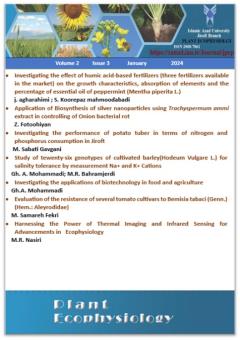Application of Biosynthesis of silver nanoparticles using Trachyspermum ammi extract in controlling of Onion bacterial rot
محورهای موضوعی : Journal of Plant ecophysiology
1 - گروه گیاه پزشکی، واحد جیرفت، دانشگاه آزاد اسلامی، جیرفت، ایران
کلید واژه: onion, biosynthesis, soft rot, Aqueous Extract of Ajowan and silver nanoparticles,
چکیده مقاله :
Today, the use of metal nanoparticles, as a suitable alternative to chemical poisons reduces their risk to the environment and consumers. Therefore, the aim of this study is the biosynthesis of silver nanoparticles using the aqueous extract of native Ajowan seeds and its effect against Onion bacterial rot. In this research, first, isolation and identification of pathogenic bacteria from different areas of Jiroft city was done. Then the biosynthesis of Ag NPs was carried out by aqueous extract of Ajowan seeds and the their effects against Pectobacterium were investigated in laboratory and warehouse conditions. A total of 12 bacterial isolates, N3 isolate from Anbarabad region had the highest pathogenicity. The biosynthesis of Ag NPs was confirmed by observing the date color after 15 minutes in the dark at room temperature and the ultraviolet spectrometer showed that the surface plasmon resonance is at 420 nm. The growth inhibition rate of biosynthesized Ag NPs and Mancozeb poison each alone and their combination against Pectobacterium in vitro were 62.45, 100 and 88.67%, respectively. Also, Ag NPs and Mancozeb each alone within three months and combining them together within two months caused 100% shelf life of onions in storage. However, the combination of biosynthesized Ag NPs and Mancozeb together with Pectobacterium had 100% inhibition in the first and second month and 85% in the third month against bacterial rot disease. Therefore, the results showed that biosynthesized Ag NPs were effective in controlling pathogenic bacteria and can replace agricultural toxins.
امروزه استفاده از نانوذرات فلزی به عنوان جایگزینی مناسب برای سموم شیمیایی خطر آن را برای محیط زیست و مصرف کنندگان کاهش می دهد. بنابراین، هدف از این مطالعه بیوسنتز نانوذرات نقره با استفاده از عصاره آبی دانههای عجوان و تأثیر آن بر پوسیدگی باکتریایی پیاز است. در این تحقیق ابتدا جداسازی و شناسایی باکتری های بیماری زا از مناطق مختلف شهرستان جیرفت انجام شد. سپس بیوسنتز نانوذرات نقره توسط عصاره آبی دانه عجوان انجام شد و اثرات آنها بر روی پکتوباکتریوم در شرایط آزمایشگاهی و انبار بررسی شد. در مجموع 12 جدایه باکتریایی، جدایه N3 از منطقه عنبرآباد بیشترین بیماری زایی را داشت. بیوسنتز نانوذرات نقره با مشاهده رنگ تاریخ پس از 15 دقیقه در تاریکی در دمای اتاق تایید شد و طیف سنج فرابنفش نشان داد که تشدید پلاسمون سطحی در 420 نانومتر است. نرخ مهار رشد نانوذرات نقره بیوسنتز شده و سم Mancozeb هر کدام به تنهایی و ترکیب آنها در برابر پکتوباکتریوم در شرایط آزمایشگاهی به ترتیب 45/62، 100 و 67/88 درصد بود. همچنین، نانوذرات Ag و Mancozeb هر کدام به تنهایی در مدت سه ماه و ترکیب آنها با یکدیگر در طی دو ماه باعث ماندگاری 100 درصدی پیاز در انبار شد. اما ترکیب نانوذرات نقره بیوسنتز شده و مانکوزب همراه با پکتوباکتریوم در ماه اول و دوم 100 درصد و در ماه سوم 85 درصد در برابر بیماری پوسیدگی باکتریایی مهار شد. بنابراین، نتایج نشان داد که نانوذرات نقره بیوسنتز شده در کنترل باکتری های بیماری زا موثر بوده و می توانند جایگزین سموم کشاورزی شوند.


